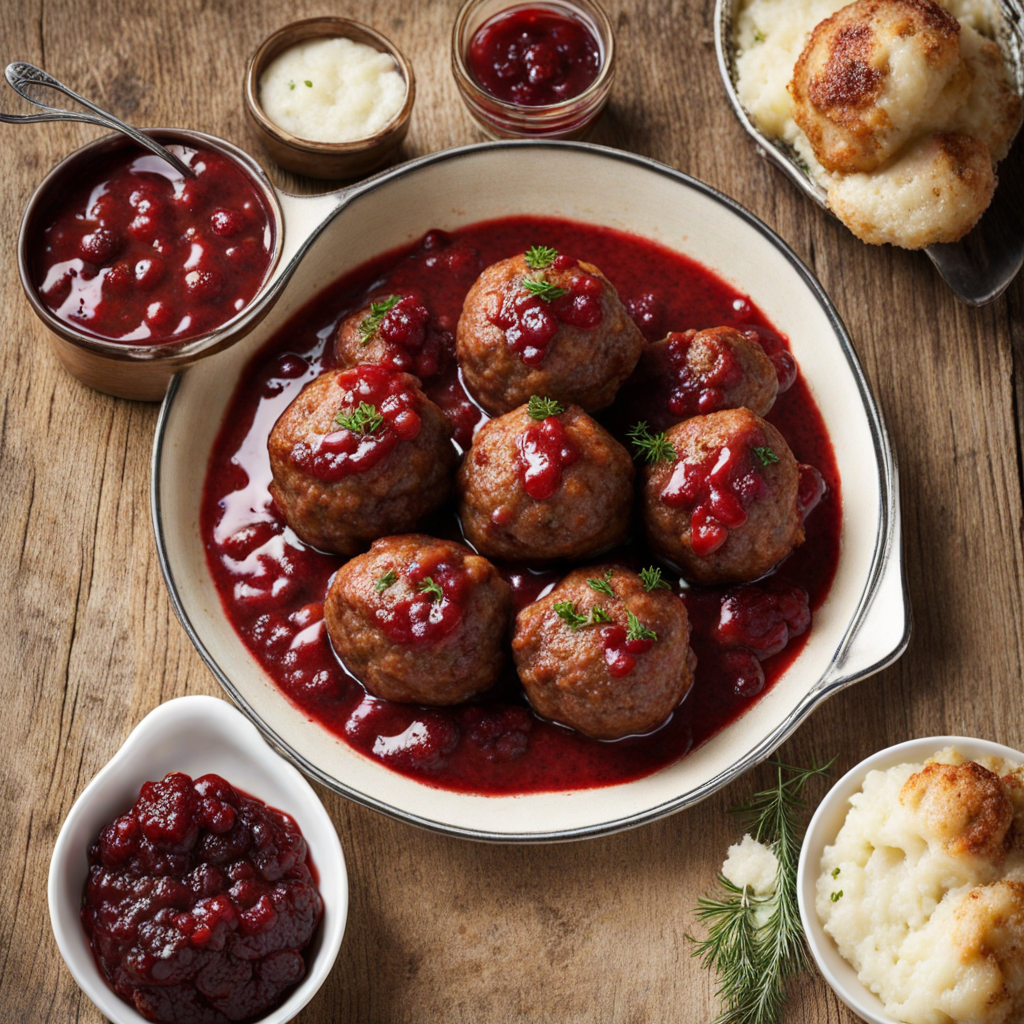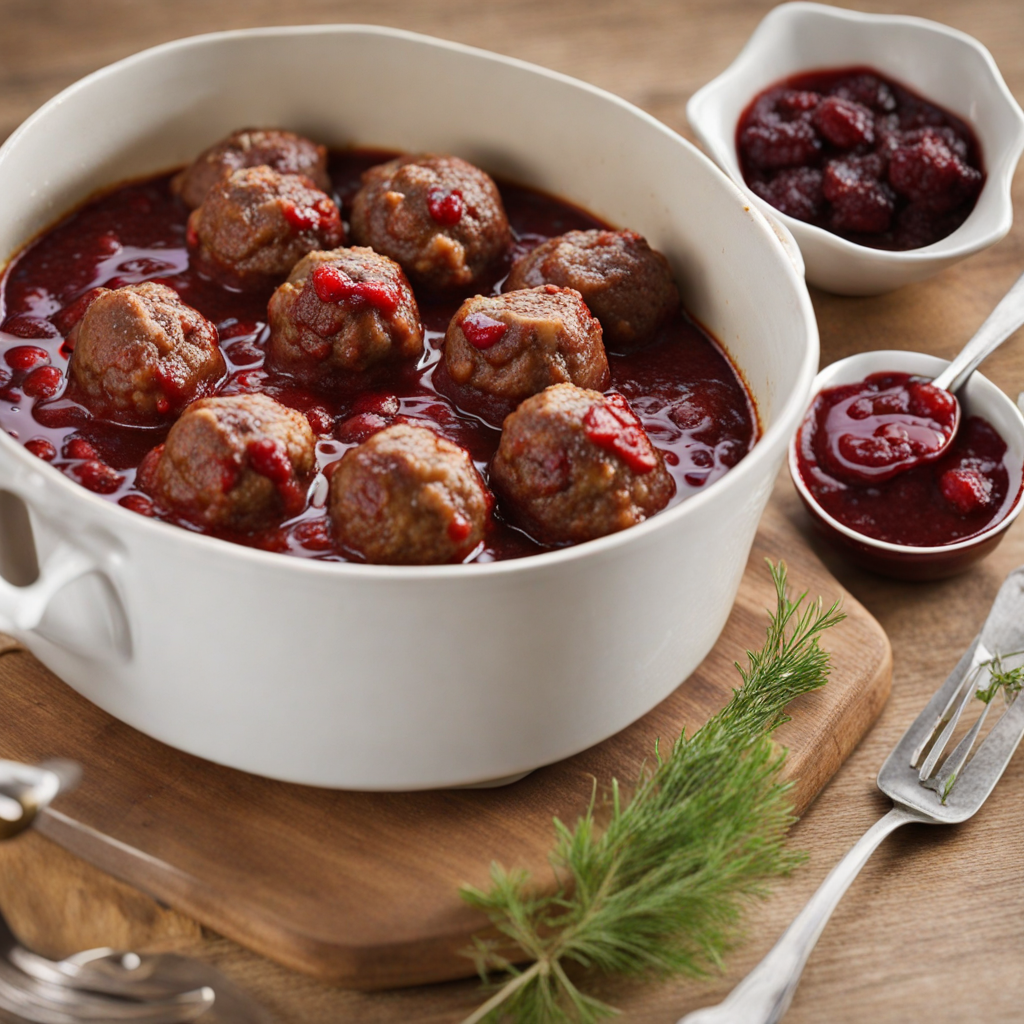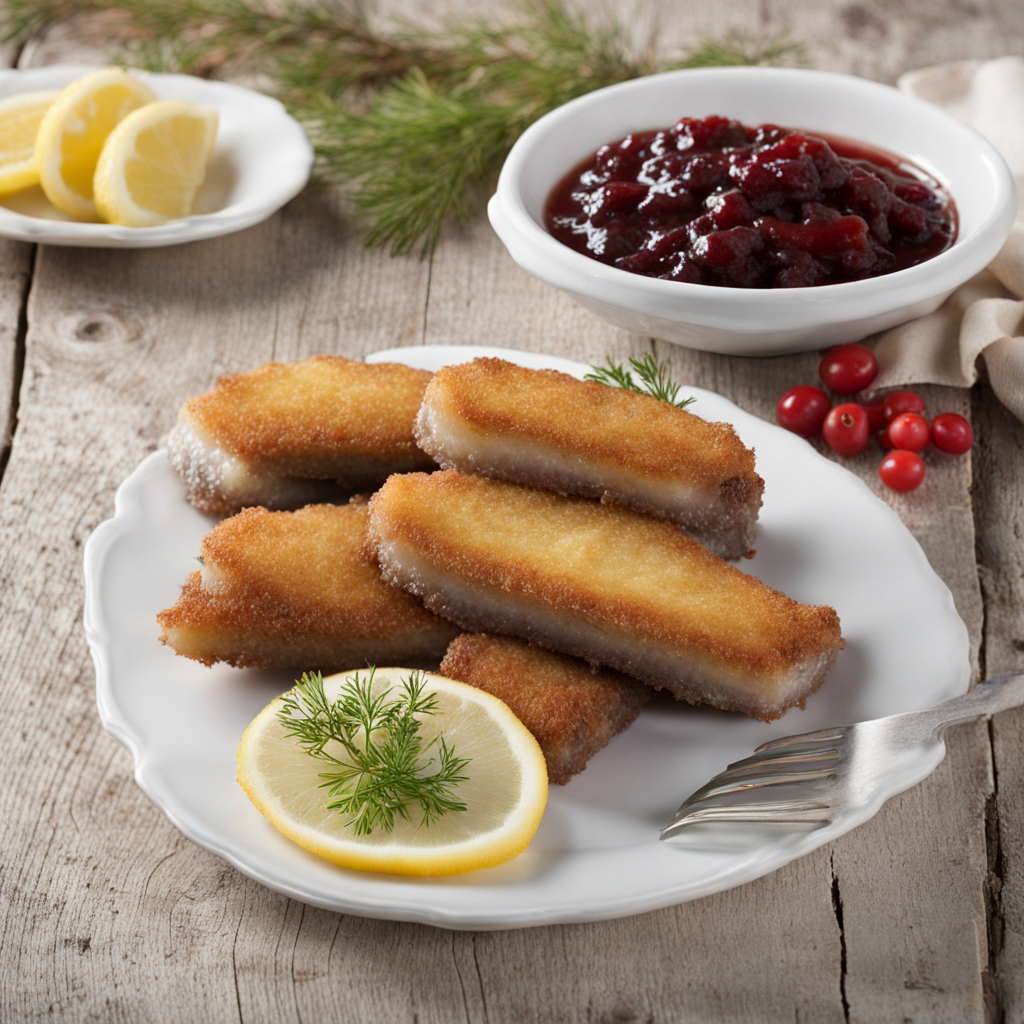Meatballs
Swedish meatballs, or "köttbullar," are a beloved dish that embodies the heart of Swedish home cooking. These small, round morsels are typically made from a blend of ground beef and pork, seasoned with onions, breadcrumbs, and a hint of spices such as allspice and nutmeg, giving them a warm and inviting flavor profile. The mixture is rolled into bite-sized balls and pan-fried until golden brown, resulting in a crispy exterior that perfectly complements the tender, juicy interior. Each bite is an explosion of savory goodness, showcasing the balance of flavors that make this dish a staple in Swedish cuisine. Served traditionally with creamy brown gravy, Swedish meatballs are often accompanied by lingonberry sauce, which adds a delightful tartness that cuts through the richness of the meat. The combination of the savory gravy and the sweet-tart berries creates a unique taste experience that is both comforting and refreshing. On the side, you may find creamy mashed potatoes or buttered noodles, adding to the dish's hearty appeal and making it a perfect meal for any occasion. Beyond their delicious taste, Swedish meatballs also carry a sense of tradition and warmth, often enjoyed during festive gatherings and family meals. They are a symbol of Swedish hospitality and are frequently served at holiday feasts, showcasing the country's love for good food and togetherness. As you savor each meatball, you're not just tasting a dish; you're experiencing a piece of Sweden's culinary heritage, where simple ingredients come together to create something truly extraordinary.
How It Became This Dish
The History of Köttbullar: Sweden's Beloved Meatballs Köttbullar, the iconic Swedish meatballs, have become synonymous with Swedish cuisine and culture, embodying a rich tapestry of history, tradition, and culinary evolution. These savory morsels, often served with lingonberry sauce and creamy gravy, are not just a meal; they are a symbol of Swedish hospitality, family gatherings, and a deep-rooted culinary heritage. #### Origins: A Culinary Journey The origins of köttbullar can be traced back to the medieval period in Sweden. Like many dishes that have stood the test of time, köttbullar evolved from simple beginnings. The word "köttbullar" translates to "meatballs," where "kött" means meat and "bullar" means balls. The concept of shaping minced meat into balls is not unique to Sweden; variations of meatballs can be found in numerous cultures around the world, from Italian polpette to Middle Eastern kofta. In Sweden, the tradition of making meatballs likely emerged as a practical solution for preserving and utilizing leftover meats. In the colder climates of Northern Europe, where food preservation was essential, minced meat was combined with breadcrumbs, rice, or potatoes, and flavored with spices to create a dish that was both filling and economical. The use of spices such as allspice and nutmeg, which are commonly found in Swedish meatballs today, reflects the influence of trade routes that introduced exotic flavors to the Nordic region. #### Cultural Significance: More Than Just a Meal Köttbullar holds a special place in Swedish culture. They are often served during traditional family gatherings, festive occasions, and holidays, such as Midsummer and Christmas. The dish epitomizes the concept of "lagom," a Swedish term that translates to "just the right amount," reflecting the Swedish ethos of moderation and balance in both life and cuisine. The meatball is also a quintessential part of the Swedish "smörgåsbord," a buffet-style meal featuring a variety of dishes that encourages sharing and socializing. This communal aspect resonates with the Swedish value of togetherness, where food acts as a catalyst for connection among family and friends. Moreover, köttbullar is a staple in Swedish homes and restaurants alike. Its status as a comfort food is undeniable; the combination of tender meat, creamy sauce, and tangy lingonberries evokes a sense of nostalgia and warmth. It is often the first dish introduced to children, reinforcing its role in the fabric of family life and Swedish culinary education. #### Development Over Time: From Farm to Table The evolution of köttbullar reflects broader changes in Swedish society and its culinary landscape. In the 18th century, as Sweden began to embrace modernization and urbanization, the meatball transitioned from a rustic dish to a more refined culinary offering. The introduction of potatoes in the late 18th century, a staple that would become a quintessential pairing with meatballs, further changed the way köttbullar were prepared and enjoyed. In the 19th century, the industrial revolution brought about significant changes in food production and consumption. As more people moved to cities, the preparation of traditional dishes like köttbullar adapted to the needs of urban life. Convenience became key, and recipes began to include pre-made breadcrumbs and other shortcuts to save time. Despite these changes, the core essence of köttbullar remained intact, with families passing down their beloved recipes through generations. The 20th century witnessed the globalization of cuisine, and Swedish meatballs gained international fame, particularly in the United States. The Swedish-American community played a crucial role in popularizing köttbullar outside Sweden, often serving them at community gatherings and Swedish festivals. The dish became emblematic of Swedish identity abroad, celebrated for its comforting flavors and hearty nature. #### The IKEA Effect: Global Popularization The late 20th century brought a new wave of popularity for köttbullar, thanks in large part to the Swedish furniture giant IKEA. The company introduced its signature meatballs in stores worldwide, serving them in its in-house restaurants and showcasing them in its food markets. This strategic move not only introduced köttbullar to a global audience but also cemented their status as a staple of Swedish culture. IKEA's meatballs, often served with mashed potatoes, lingonberry sauce, and gravy, became a culinary icon associated with the brand. The accessibility of these meatballs led to a surge of interest in Swedish cuisine, prompting people to explore traditional recipes and cooking methods. As a result, köttbullar transformed from a local dish to an international sensation, embraced by food lovers around the world. #### Modern Interpretations and Variations Today, köttbullar continues to evolve, with chefs and home cooks experimenting with diverse ingredients and flavors. While traditional recipes typically feature a mixture of beef and pork, modern interpretations may include alternative meats, plant-based proteins, or unique flavorings such as feta cheese or herbs. These innovations reflect a growing awareness of dietary preferences and a desire for culinary exploration. Swedish meatballs have also found their way into fusion cuisine, where they are incorporated into dishes like meatball subs, sliders, or served with international sauces. This adaptability speaks to the timeless nature of köttbullar, which can be both a canvas for creativity and a comforting reminder of home. #### Conclusion: A Dish of Heritage and Hospitality Köttbullar is more than just a dish; it is a reflection of Swedish history, culture, and identity. From its humble beginnings in medieval kitchens to its status as a global culinary icon, the meatball has transcended geographical and cultural boundaries. It remains a beloved dish in Sweden, celebrated for its comforting qualities and its ability to bring people together. As we enjoy köttbullar today, whether at a family gathering, a festive celebration, or a quick meal from IKEA, we partake in a rich heritage that has been lovingly crafted over centuries. Each bite carries with it the stories of generations, the warmth of Swedish hospitality, and a reminder that food is not just sustenance but a bridge connecting us to our past and one another.
You may like
Discover local flavors from Sweden







